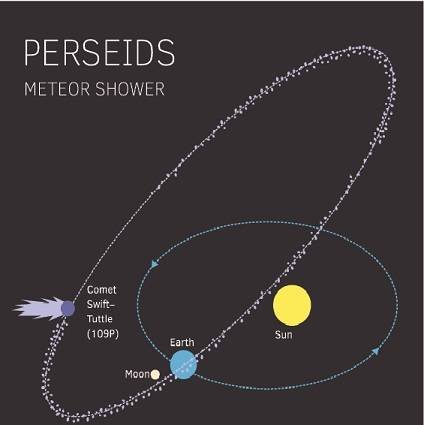How to see the Perseid meteor shower from July 17 to August 24
Every July and August Planet Earth crosses the debris field left behind by the Swift-Tuttle comet orbiting the Sun every 133 years.
More precisely from July 17 to August 24, with the peak meteor shower activity — when Earth passes through the area where there's more debris and dust — occurring between August 11 and August 12, we'll be able to see one of the most fiery meteor showers.
The best place to see the Perseid meteor shower is from anywhere in the northern hemisphere. If you're on the southern hemisphere but close to the equator you can still see some meteors low on the horizon.
The best time to see a meteor shower is at night with a clear sky, preferably out of town where there's a lot of ambient light pollution. Take a blanket outside and enjoy the view because there'll be more than 150 -200 visible flashy meteor fireballs an hour! Maybe you want to make a wish when you see one! :)
Perseid meteoroids (which is what they're called while in space) enter Earth's atmosphere (and are then called meteors) at roughly 60 kilometers per second. Most are the size of sand grains; a few are as big as peas or marbles. Almost none hit the ground, but if one does, it's called a meteorite.
Why is it called Perseid meteor shower when the comet name is Swift-Tuttle?
Lewis Swift and Horace Parnell Tuttle are the name of the american astronomers that discovered the 27km wide comet in 1862.
It's called Perseid because the meteor shower appears to radiate from the constellation of Perseus.
To find it turn your head toward the North-West and raise you eyes to rest about 40° above the horizon.
Graphic of Earth crossing orbit of Swift-Tuttle comet. Photo credit: Shutterstock
Wait a minute! If we cross the orbit of a 27km object every year, that means sometime we'll collide with it?
Yes, there is that possibility! Comet Swift–Tuttle has been described as:
"the single most dangerous object known to humanity".
[Verschuur, Gerrit L. (1997). Impact!: the threat of comets and asteroids]
An Earth impact would have an estimated energy of about 27 times that of the Cretaceous–Paleogene impactor, the object that supposedly is responsible for 75% of plant and animal extinction back then.
But don't worry about that now, maybe in the year 3044 Swift-Tuttle will whiz by Earth at 1 million km away...


Congratulations @serggioc! You have completed some achievement on Steemit and have been rewarded with new badge(s) :
Click on any badge to view your own Board of Honor on SteemitBoard.
For more information about SteemitBoard, click here
If you no longer want to receive notifications, reply to this comment with the word
STOPThank you.
I got a bellyRub and this post has received a 0.59 % upvote from @bellyrub thanks to: @serggioc.
Thank you.
You are very welcome1.
Congratulations @serggioc! You have completed some achievement on Steemit and have been rewarded with new badge(s) :
Click on any badge to view your own Board of Honor on SteemitBoard.
For more information about SteemitBoard, click here
If you no longer want to receive notifications, reply to this comment with the word
STOP